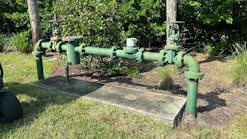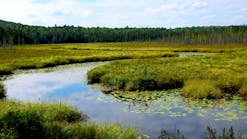A decade ago, Dr. Allan Hoffman was preparing an article on water-energy issues when a phrase popped into his head: “water-energy nexus.” Unsure the term “nexus” would be understood, Hoffman enlisted the opinion of a colleague, who found it acceptable. Today, the phrase is renowned for describing the symbiotic relationship between water and energy. It also symbolizes the vast contributions Hoffman, a recently retired senior analyst in the Office of Energy Efficiency and Renewable Energy/US Department of Energy (DOE), has made through his work.
“Water-energy issues have become much more popular and visible,” says Hoffman, pointing out as an example his Swedish colleague Gustaf Olsson’s recently published book, Water and Energy-Threats and Opportunities, in addition to the numerous workshops on the subject. Over the past 17 years, he’s been responsible for 85 articles and speeches relating to water and energy. His latest: “Energy and Water: A Critical Linkage,” is a chapter in a forthcoming book, Global Energy Poverty: The Silent Crisis by Benjamin K. Sovakool. Hoffman has left his mark in other ways: He was the principal author of the 1975 legislation establishing the US Corporate Average Fuel Economy regulations, designed to improve the average fuel economy of cars and light trucks sold in the US in the 1973 Arab Oil Embargo aftermath. He also led a 30-agency Domestic Policy Review of the Federal Renewable Energy Policy in 1978.
How He Spends His Days
Hoffman has a new blog, Thoughts of a Lapsed Physicist (www.lapsedphysicist.org). He’s a Visiting Professor of Renewable Energy and Desalination at Gulf Organization for Research and Development in Qatar. Additionally, he is a Fellow of the American Physical Society and the American Association for the Advancement of Science.
What Led Him Into This Work
Hoffman earned a Bachelor of Engineering Physics degree from Cornell University and a Ph.D. in solid state physics from Brown University. He worked as a research intern/physicist at IBM, Los Alamos National Laboratory and Texas Instruments. In 1968, Hoffman joined the University of Massachusetts/Amherst Physics and Astronomy Department faculty. A year later, he befriended faculty member Dr. David Inglis, who had been part of the atomic bomb project at Los Alamos during WWII before serving as a senior scientist at Argonne National Laboratory.
“David [Inglis] introduced me to the subjects of arms control and energy and changed my life,” says Hoffman, whose interest in nuclear and other energy forms sparked. He taught and debated those issues in 1970. In 1974, he put his research career in low temperature solid state physics on hold to take an American Physical Society Congressional Fellowship, arriving in Washington D.C. several months after the oil embargo began and two weeks after President Nixon resigned.
Hoffman chose a fellowship year assignment as a US Senate Committee on Commerce and Transportation staff scientist to obtain broad exposure to how Congress addressed energy and other science and technology issues. He stayed in Washington D.C., holding various policy and management positions, including Director, Advanced Energy Systems Policy Division, DOE; Assistant Director for Industrial Programs, Energy Productivity Center, Mellon Institute/Carnegie-Mellon University; and Consultant and Senior Analyst, Office of Technology Assessment, US Congress. In 1982, he joined the US National Academy of Sciences/National Research Council staff, serving as executive director of the Committee on Science, Engineering and Public Policy. In 1990, he returned to DOE as Associate and Acting Deputy Assistant Secretary for Utility Technologies, leading a $300 million RD&D program encompassing solar, wind, biomass, geothermal, hydropower, ocean, energy storage, hydrogen, and superconductivity. He has also served as US Representative to and Vice Chairman of the International Energy Agency’s Working Party on Renewable Energy.
What He Likes Most About His Profession
“I love physics and its practical applications, making a difference, helping people, and working with young people,” he notes.
How He’s Meeting His Greatest Challenge
In previous years, Hoffman’s challenge was to educate people about the possibilities of clean energy and help develop clean energy technologies. “My greatest challenge at present is how best to share my experience and knowledge accumulated over many years with those who will succeed me,” says Hoffman. He will do so through his blog, other writings, and as a volunteer to help bring a children’s science center to northern Virginia.






